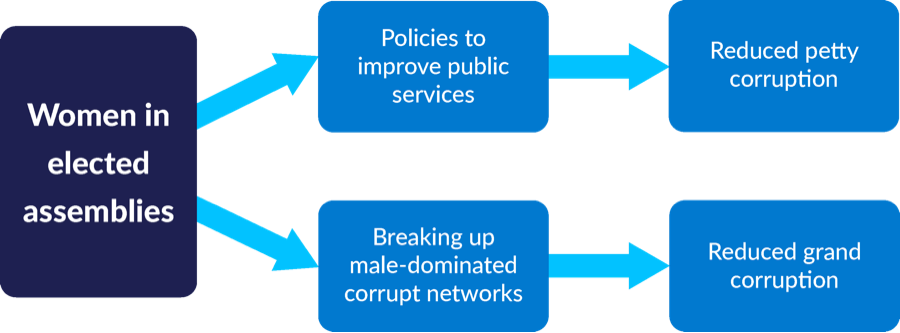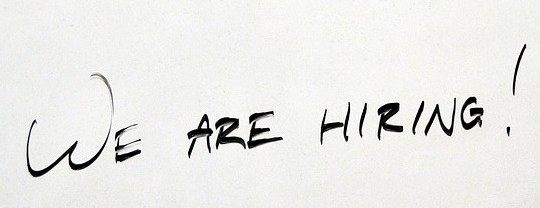Highlights:
- DFID offers a new approach to cost recovery and transparency on grants
- Getting data right
- Bribery and money laundering – where’s the punishment?
- Is open feminist government the answer to transparency?
- Making the case for extractives industries transparency
- Towards impactful civic engagement
- Deep dive: shaping learning questions in a funder collaborative
In case you missed it…
DFID offers new approach to cost recovery and transparency on grants
Will DFID’s new approach put an end to “non-profit starvation cycle”?
 Photo: stevepb at Pixabay
Photo: stevepb at Pixabay
Many CSOs struggle with calculating the true costs of delivering donor-funded projects, and end up eating into their own funds to cover indirect expenses. This has been proven to be unsustainable, especially for smaller CSOs. The UK Department for International Development (a TAI affiliate member) has introduced new guidelines for “more transparent and fair” delivery of grants. Graham Mackay and Tim Boyes-Watson discuss the seven principles and main features of this new model. Dig deeper and download the templates and guidelines designed to enable CSOs to negotiate sufficient funding to cover full costs.
DFID isn’t the only one rolling out innovations. For the first time, USAID is comparing one intervention against another. Called the A/B test, the aid agency found differences in outcomes between groups in Rwanda who received holistic interventions and those who received cash with no strings attached. According to Michael Faye and Paul Niehaus, USAID’s experience highlights the need for donors to be more systematic in evaluating interventions, and the value of cash not as a replacement for interventions but a yardstick for comparison. According to them, “if an intervention isn’t more effective than cash, then perhaps the donors should switch gears”.
Still on donor practices, Alan Cantor breaks down the good and the bad with donor-advised funds. Drummond Pike goes a little further, recognizing his role in creating the donor-advised fund monster. Darren Walker of TAI member Ford Foundation has also been talking about channeling funds through intermediaries, but in this case, regional networks that help support local actors to drive local solutions to development problems. “The old adage that there just isn’t anybody to give the money to in communities who we can trust, who are competent, who aren’t corrupt, is a legacy that has been disproved,” he said.
Getting data right
Fresh from a conversation with TAI, Joshua Blumenstock reminds us of the four problems why big data’s alleged silver bullets are missing their marks, and some steps towards a “humbler data science”. The problem isn’t new, and ethical principles for working with data have been around for some time. The bigger issue is how to put these principles and frameworks into action. This fresh report on how governments can “get data right” and enable the sharing and effective use of personal data towards improved public service delivery and outcomes may provide some inspiration. Pair it up with this guide for lessons on formal systems for responsible data governance and list of practical ways on how to make ethical data standards part of one’s work every day.
Another aspect of getting data “right” is accuracy. We may not pay too much attention to the obscurities of statistics agencies and statistics legislation, but Aidan Eyakuze reminds of their importance. If enacted, proposed amendments to Tanzania’s Statistics Act 2015 would mean it is no longer an offense to publish “false” statistics – a slippery slope for anyone caring about development.
Bribery and money laundering – where’s the punishment?
From curbing the flow of bribes to illicit wealth overseas, many countries do not seem to be doing a great job. Over half of the world’s biggest exporters are failing to punish corporations paying bribes overseas under the OECD Anti-Bribery Convention, according to Transparency International’s latest report. TI recommends increased enforcement efforts and publishing data, including settlements of bribery cases.
Despite the prominence of Paul Manafort’s conviction in the US, it appears that prosecuting money launderers is not so easy either (unless they get entangled in high profile politics). This week’s podcast tackles Europe’s widening money laundering scandal, and the EU’s game plan. The pressure is on for the Isle of Man, too, that has until July 2019 to improve its money laundering standards. Nor are things improving over in Malta. Monte Reel charts this tiny EU country’s journey to becoming a global hub for money laundering and corruption.
Perhaps all is not lost as the revolution in AI promises new leads in banks’ fight against dirty money. (On a similar note, how darkly do you see the world? Take the psychopath AI Rorschach test!)
Is open feminist government the answer to corruption?
Disappointed by the failures of anti-corruption reforms? Monika Bauhr, Nicholas Charron and Lena Wängnerud detail the case for more women in elected office (see also visual below). Brando Flores agrees and demonstrates the processes that aim to co-create the openness of states are sensitive to the gender approach, using Mexico as a case in point. (Don’t forget the big idea for more impactful feminist open gov from Hewlett Foundation and TAI’s Alfonsina Penaloza.)
From Close the political gender gap to reduce corruption How women’s political agenda and risk aversion restricts corrupt behaviour by CMI
Elsewhere, Mali has appointed President Ibrahim Boubacar Keita for a second five-year term after an election marred by fraud. Blair Glencorse and Moussa Kondo explain why we should pay attention. And while Mali is grappling with issues of transparency and governance, China might have to try and win countries’ support of the “China model” of development and its foreign policy approach to gain future leadership in global governance. To wrap, NewsMatch campaign is encouraging US communities to empower journalists, especially local journalists, to tell stories that spark change and hold leaders accountable.
Making the case for extractives industries transparency
In Ghana, a majority of mining and oil and gas companies incorporated or listed in Canada have disclosed payments made to the government under the Extractive Sector Transparency Measures Act (ESTMA). But how does transparency in the extractive industry benefit developing countries? Jacqueline Terrel makes the link between project level and beneficial ownership transparency to domestic resource mobilization. We’ve made similar arguments in our report on beneficial ownership transparency and tax revenue collection.
Lest we get too carried away with data potential, a global study by Inmarsat shows that 94% of mining organizations are facing significant challenges in extracting valuable insights from data gathered by the Industrial Internet of Things to improve the productivity, efficiency, and safety of their operations. The main barrier? Connectivity challenges.
Towards impactful civic engagement
In the Democratic Republic of the Congo, with the elections just three months away, authorities have been cracking down on civil society and media. In Mexico, Emmanuel Guillén Lozano narrates his story and the perils of working as a journalist when covering such issues as corruption and organized crime.
So, how to engage communities and CSOs effectively? HSF Kenya’s handbook provides lessons on how to engage with citizens in community change initiatives. According to Eric Klinenberg, start with the library. He argues that libraries stand for, and exemplify something that needs defending: the public institutions that even in an age of atomization, polarization and inequality – serve as the bedrock of civil society. Finally, this guidance from the Business and Human Rights Resource Centre and International Service for Human Rights advises companies as they address the challenges as well as opportunities to support civil society and human rights defenders.
Are you thinking how to reach the most people with your advocacy? Start with Facebook and Google apps – see their dominance in mobile screen time use globally in this visualization.
Long read of the week
Rich Russians: From Oligarchs to Bourgeoisie
See also book review published in The Guardian
TAI spotlight
Why We Invested: The Engine Room | Omidyar Network
Omidyar Network teams up with Yoti Foundation and Open Society Foundations for the Good ID dialogues by the Engine Room.
What Does a Mission-Driven HR Department Look Like? | Ford Foundation
Diane Samuels discusses Ford Foundation’s policies to embrace diversity, address inequality and value transparency within the organization.
Read our Latest Blog
Deep dive: shaping learning questions in a funder collaborative
 How can a funder collaborative engage with evidence to improve grantmaking practice? Alison Miranda from TAI in her blog observes that the first step is to ask the right learning questions. We look forward to sharing the Learning from Evidence series of products with the TAP field through our website and our research partners’ virtual platforms. In the meantime, to understand more on ‘adaptive management,’ dynamic use of evidence, information and data, read this recent report by Leni Wild and Ben Ramalingam.
How can a funder collaborative engage with evidence to improve grantmaking practice? Alison Miranda from TAI in her blog observes that the first step is to ask the right learning questions. We look forward to sharing the Learning from Evidence series of products with the TAP field through our website and our research partners’ virtual platforms. In the meantime, to understand more on ‘adaptive management,’ dynamic use of evidence, information and data, read this recent report by Leni Wild and Ben Ramalingam.

We’re looking for the next member of our great team in Washington DC. Application closes September 30. Details for the Program Associate position are on our website.
Calls: Proposals, papers, speakers and course invites
- The role of language access and the importance of interpreters in social accountability work survey – Accountability Research Center (ARC)
- Working Group in African Political Economy (WGAPE) Meeting – September 23
- Congressional Oversight Fellowships – September 27
- Money Trail Grants – July 15, September 30, November 15
- Reagan-Fascell Democracy Fellowship– October 15
- Fellowships for Investigative Journalism Conference – October 29 – 31
On the calendar
- Accountable Now webinar series – September 1 – November 30
- Feedback Summit 2018 – October 4-5 (Washington, DC, USA)
- Code for All Global Summit – October 8-12 (Bucharest, Romania)
- National Tax Conference – November 12-13 (Washington, DC)
- Ethical tech Summit – October 20 (Manhattan, New York)
- Civic Tech: India 2018 – August- November (Bangalore, Delhi and/or Mumbai, India)
- 3rd Open Data Research Symposium – September 25 (Buenos Aires, Argentina)
- Open Data Standards Day – September 26 (Buenor Aires, Argentina)
- The Future is Open: 5th International Open Data Conference – September 27-28 (Buenos Aires, Argentina)
- European Evaluation Society – Evaluation for More Resilient Societies– October 1-5 (Thessaloniki, Greece)
- Accountable Now Annual Workshop 2018 – October 10- 12 (Berlin, Germany)
- 18th International Anti-Corruption Conference – October 22-24 (Copenhagen, Denmark)
- UN World Data Forum – October 22-24 (Dubai, UAE)
- BigSurv18 – October 25-27 (Barcelona, Spain)
- Public Sector Economics 2018 Conference – Fiscal Openness: Transparency, Participation and Accountability in Fiscal Policies – October 26 (Zagreb, Croatia)
- AEA Evaluation 2018: Speaking Truth to Power – October 29 – November 3, 2018 (Cleveland, OH USA)
- Global Partnership Forum – October 30 – November 1 (Washington, DC)
- OGP Asia-Pacific Regional Meeting – November 5-6 (Seoul, Korea)
- Canadian Open Data Summit – November 7-9 (Ontario, Canada)
- Data4Good Conference – November 14 (Birmingham, UK)
- ODI Summit – Data | Value – November 20 (London, UK)
- Outcome-Oriented Monitoring, Evaluation & Learning – December 3-5 (Nairobi, Kenya)
- Collective Impact Forum Convening – May 14-16, 2019 (Chicago, USA)
- Global Conference on Transparency Research – June 26 – 27, 2019 (Rio de Janeiro, Brazil)

 Photo:
Photo: 